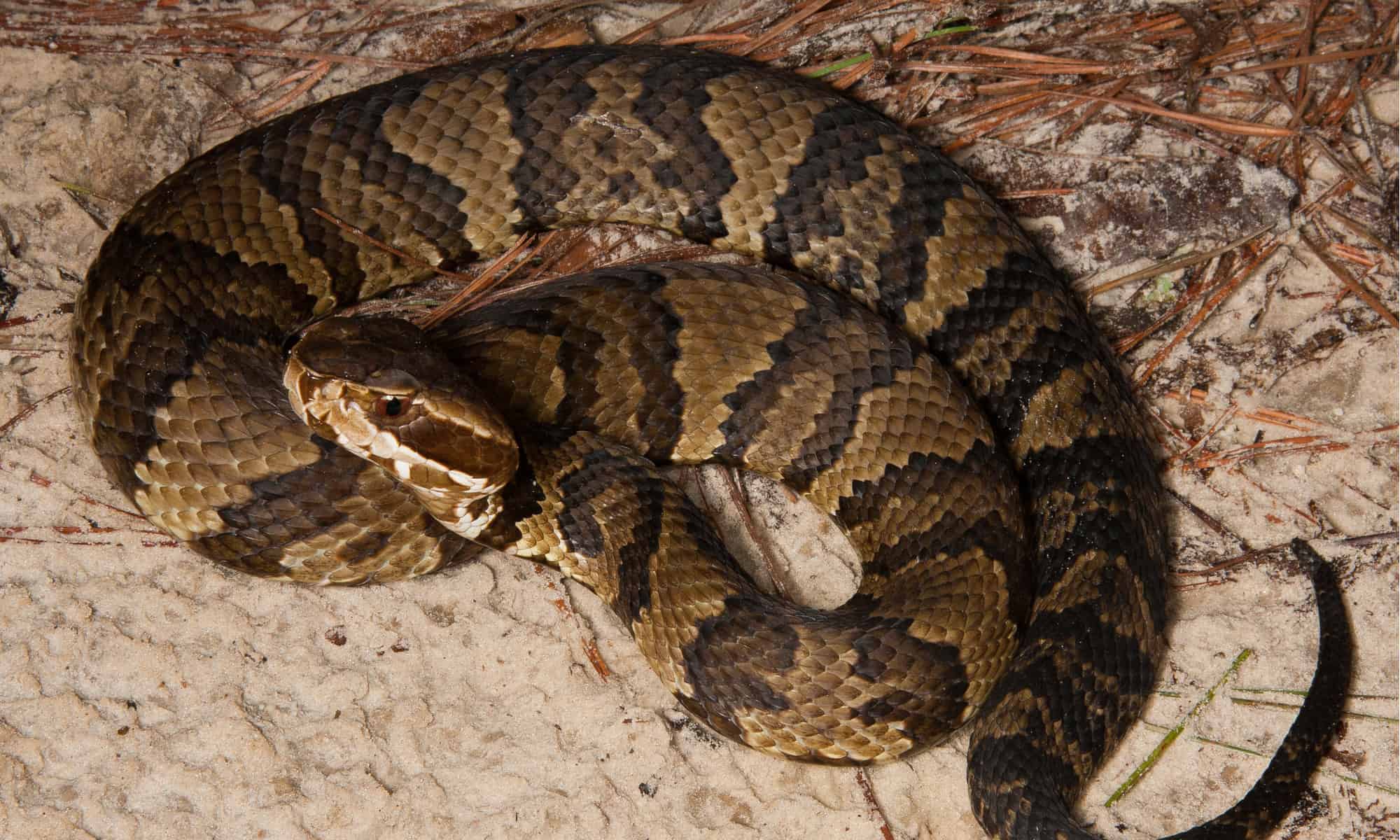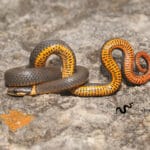Dive into the wild world of cottonmouth snakes! This exploration takes you beyond captivating photos and fascinating facts. Discover the secrets of these remarkable creatures, learn to identify them in their natural habitat, and understand their captivating behaviors. We’ll even uncover the importance of protecting these amazing reptiles. So, let’s embark on this cottonmouth snake expedition!
Deciphering the Cottonmouth: A Visual Guide
Venomous snakes hold a certain allure. Their dangerous beauty captivates us, and the cottonmouth sits at the top of this intriguing list. With its bold appearance, assertive demeanor, and behavior worthy of a nature documentary, the cottonmouth is a truly fascinating creature. Let’s use visuals as our guide to understanding this often-misunderstood reptile.
Cottonmouth Identification: It’s All in the Details
Knowing how to spot a cottonmouth is crucial, not just for safety, but for appreciating these snakes better. Think of a cottonmouth picture as its ID card.
Most cottonmouths sport a dark outfit—black or deep brown—but here’s the key: they’re not just one solid color. They have distinctive crossbands, like stripes, usually 10 to 17 of them, running down their bodies. These bands are typically lighter in the middle, making them stand out.
The head is another giveaway. Wide and triangular, like a stealth fighter jet, it’s framed by those telltale jowls. When a cottonmouth feels threatened, its jowls flare out, revealing the startling white lining inside its mouth—hence the nickname “Water Moccasin.” That’s nature’s way of saying, “You’ve been warned!”
Decoding Cottonmouth Behavior: Don’t Tread on Me
Cottonmouths have earned their reputation. Those pictures of them with their mouths wide open, fangs on display? That’s not for show. They’re not just trying to look tough; it’s a serious defense mechanism.
Here’s the crucial thing about cottonmouths: they’d much rather avoid a confrontation. They’re not actively hunting humans. But—and this is important—if they feel threatened, they will stand their ground. That venom? It’s their secret weapon, and they won’t hesitate to use it if they have to.
But there’s more to these snakes than venom and defense. Cottonmouths are adaptable predators, feasting on a surprisingly diverse menu of fish, amphibians, small mammals, and even other snakes! They play a crucial role in their ecosystem, keeping populations in balance.
Appreciating the Cottonmouth: Beauty in the Danger
Pictures of cottonmouths aren’t just about safety and identification. They’re a window into their world, a chance to see these creatures in a new light. We can marvel at the intricate patterns on their scales, the way they move with fluid grace, and even the look in their eyes—a glimpse into the mind of a wild animal.
These pictures can foster a deeper respect for cottonmouths. By seeing them in their natural habitats, we begin to understand how important they are to the ecosystem. They’re not just scary snakes; they’re vital players in the delicate balance of nature.
Respectful Photography: Observe, Don’t Disturb
If you’re lucky enough to encounter a cottonmouth in the wild, always remember: observe from a safe distance. No picture is worth putting yourself or the snake at risk. Use a zoom lens if you need to get a closer shot, but never try to handle or harass a cottonmouth.
And let’s not forget about conservation. Cottonmouths, like many other species, face threats from habitat loss, pollution, and human interference. By raising awareness through our pictures and supporting conservation efforts, we can help ensure these incredible creatures have a future.
So, the next time you see a picture of a cottonmouth, take a moment to appreciate its beauty, understand its role in nature, and remember the importance of respect and conservation.
Cottonmouth Aggression: Separating Fact from Fiction
How Aggressive Is a Cottonmouth?
So, you’re curious about cottonmouths and their reputation for being aggressive. It’s true; they are venomous snakes. But would they rather be left alone? Absolutely. These snakes are actually quite shy, and biting is a last resort if they feel trapped or threatened. Knowing how they behave and taking a few simple precautions can dramatically reduce the chances of getting bitten.
Let’s set the record straight: cottonmouths aren’t out hunting for humans to bite. Their venom is primarily for hunting their usual prey and for self-defense if something larger and scarier—like us!—gets too close.
Now, about that “aggressive” behavior… Sometimes a cottonmouth might do what seems scary, like opening its mouth wide (showing off that cotton-white lining that gave it its name), vibrating its tail, or flattening its body to look bigger. But honestly, it’s simply trying to tell you to back off! It’s not looking for a fight, just trying to avoid one.
“If they feel threatened, they may show their white mouth and fangs as a warning and shake their tail. If that is the case, just walk away. They won’t chase you.” – Florida Museum
Here’s the truth about cottonmouths and people: they really don’t want to chase us. If a cottonmouth senses you coming, it’s more likely to slither away and hide than stick around.
Sharing Space Safely: Tips for Peaceful Coexistence
So, how do we share the same space safely? It’s all about respect and awareness. Give cottonmouths a wide berth if you see one – just like you’d hope others would do if they saw you on a bad day! Be mindful of where you’re stepping, especially in areas with tall grass, by the water’s edge, or other places they might like to hang out.
A little knowledge goes a long way, too! The more you learn about where cottonmouths live and how they act, the better you’ll be at avoiding any surprise encounters. And, if you do happen to come across one, don’t try to be a hero. Just back away slowly and let the professionals handle it.
Beyond “Water Moccasin”: The Many Names of the Cottonmouth Snake (And What They Tell Us)
What are other names for a cottonmouth snake?
We’ve been talking about cottonmouth snakes, but did you know these serpents have a whole collection of aliases? It’s true! These nicknames come from all sorts of places – where people live, local folklore, and even how the snake looks. Knowing these alternative names isn’t just interesting trivia—it’s actually quite important for staying safe and protecting these often-misunderstood creatures.
You’ve probably heard them called “water moccasins.” It’s a pretty common name, almost as popular as “cottonmouth.” But here’s the thing: “water moccasin” can also refer to some completely harmless water snakes. This causes a lot of confusion and can even lead to people mistakenly harming a non-venomous snake.
Another common nickname is “gaper,” which perfectly describes what these snakes do when they feel threatened. They open their mouths wide, showing off that cotton-white inside—hence the name “cottonmouth.” It’s their way of saying, “Back off!” not necessarily “I’m going to bite you.”
In some areas, people call them “mangrove rattlesnakes.” This one makes sense because cottonmouths love hanging out near water, including mangrove swamps. And while they don’t have rattles like their rattlesnake relatives, they do vibrate their tails when they’re agitated, which might explain the confusion.
Then there’s the name “swamp lion.” Now, that’s a name that commands respect! It speaks to the cottonmouth’s reputation as a skilled and powerful predator in its watery domain.
One name that pops up sometimes is “water mamba,” but this one is entirely inaccurate. Real mambas are found all the way over in Africa and Asia. They’re not even related to cottonmouths. The “water mamba” label probably comes from the fact that cottonmouths live in watery areas and have a venomous bite, just like mambas.
So, there you have it! Cottonmouths, with their many names, are a truly fascinating part of the natural world. Understanding these different names not only gives us a glimpse into how people perceive these snakes, but also helps us appreciate the importance of accurate identification and responsible interaction with wildlife.
Cottonmouth Size: Debunking Myths & Revealing the Record Breaker
How big is the biggest cottonmouth snake?
We’ve discussed how big cottonmouths can get, and it’s true that most are around 2 to 4 feet long. That’s already pretty big for a snake! But every now and then, you hear whispers of something bigger, something that could make your hair stand on end. Some folks swear they’ve seen cottonmouths longer than a grown man!
Could they be exaggerating? Possibly. But there have been some pretty credible reports of cottonmouths stretching over 6 feet long. Imagine coming face to face with that in the swamp!
The biggest cottonmouth ever officially recorded was caught back in 1990 in Virginia’s Dismal Swamp. Get this – it measured a whopping 74 inches, which is just a smidge over 6 feet!
Now, before you get all freaked out, remember that even though they’re packing venom, cottonmouths aren’t out to get you. They’d much rather be left alone, soaking up the sun on a log or snagging a fish for dinner. However, if they feel cornered or threatened, they will defend themselves, and a bite from one of these guys is no joke. Their venom is powerful stuff, so it’s always best to admire them from a safe distance.
Speaking of distance, you’re more likely to encounter a cottonmouth near water. They love hanging out in swamps, marshes, and along the edges of lakes and rivers. They’re actually pretty graceful swimmers, even strong enough to swim against the current. On land, they tend to be a bit slower and clumsier, and honestly, they’d rather avoid a confrontation just as much as you would.
So, the next time you’re out exploring the great outdoors, remember that cottonmouths are a part of the natural environment, and they play an important role in the ecosystem. If you happen to spot one, consider yourself lucky to witness such a fascinating creature in the wild. But remember – keep a respectful distance and let it go about its business.
** Internal Links:**
Prepare to be amazed by the sight of millions of years old petrified dinosaur poop that somehow survived the test of time. Learn about its geological journey and how paleontologists use it to piece together the history of our planet.
If you’ve never seen a groundhog “woodchuck” in the wild, here is your chance! Click on this picture of a groundhog woodchuck and catch a glimpse of this adorable and fascinating creature.
- Jerry McSorley’s Post-Divorce Life: New Beginnings - July 16, 2025
- The Rise and Fall of the New Haven Nighthawks: A Minor League Hockey Legacy - July 16, 2025
- Unlock Jerry McSorley’s Career Highlights: Eye Tax Inc.’s Solar Success - July 16, 2025

















2 thoughts on “Cottonmouth Snake Pictures: Identification, Safety, and Captivating Images”
Comments are closed.